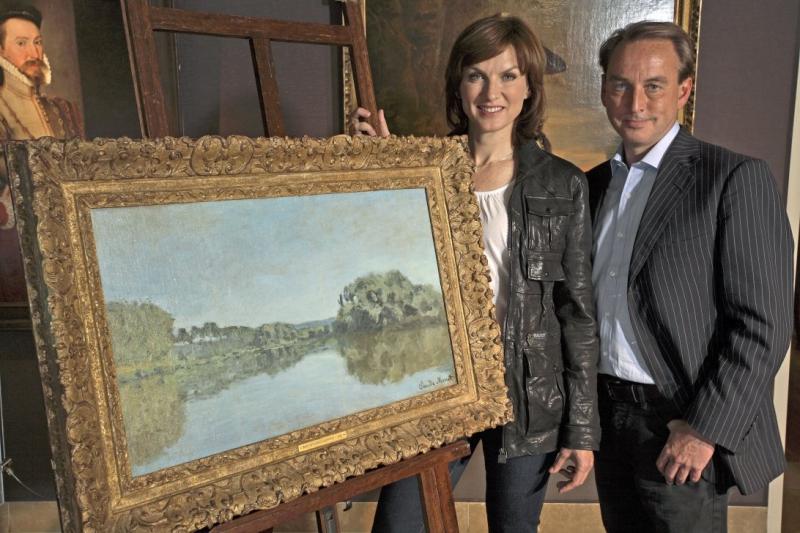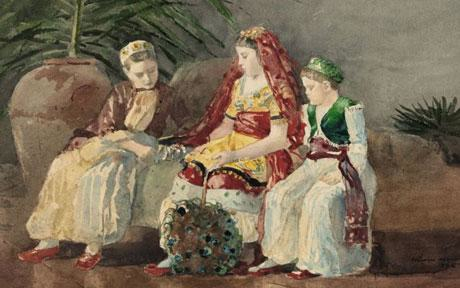Fake or Fortune?, Episodes 1 & 2, BBC One | reviews, news & interviews
Fake or Fortune?, Episodes 1 & 2, BBC One
Fake or Fortune?, Episodes 1 & 2, BBC One
A Monet the establishment won't accept, a rubbish tip find worth £200,000? Tales of art skullduggery

Fake or Fortune? on BBC One, with Fiona Bruce and art dealer and sleuth Philip Mould, ought to have been called CSI: Cork Street for its blend of fine art and forensic science. They were trying to resolve whether a Monet was in fact a Monet, using a 240 million-pixel camera, Monet's own accountbook (which Fiona Bruce ran her ungloved fingers across) and plenty of ominous music. Next up: who killed Marat in David's picture?
The mystery of fakes, forgeries and misattributions becomes ever more fascinating as pictures fetch greater prices at auction; Monet's record stands at £41 million. The National Gallery recently held an exhibition of fakes to illustrate their persistence and frequent high quality. David Joel, the owner of the potential Monet (too easy to mistype as Money) must have been thrilled he'd got the BBC to take up the trail, which involved sailing down a river to see if Monet could have seen the same view, tracing gallery labels to Cairo and digitally analysing pretty much everything about the painting.
Wrapping a programme on art authentication within the mystery of an actual disputed case was a great idea, so we absorbed the latest in technological detection while rooting for the owner. There were too many tropes of forensic television - chunks of exposition, cliffhangers, dark hints - and the programme was pitched at times surprisingly low: "Monet was one of a group of revolutionary artists..." Philip Mould, who has had major successes in uncovering misattributed masterpieces, did not glorify himself to anyone who appreciates Monet when he said: "This is not art you have to be trained to like." The lowest common denominator was unlikely to be watching Fake or Fortune?, thus there was no need to stoop to please it.
Unusually for such well-planned programmes - they didn't happen on a private Cairene residence of a millionaire art collector by accident - there was unexpected drama when French Customs stopped Mould trying to take the painting out of France, which he found somewhat surprising. Fiona Bruce stridently upbraided a French official - in French - and eventually the painting was recovered, but a genuine crisis made this much more interesting.
What the programme ultimately showed, however, is that all the technology in the world can't settle a question of attribution. Mould introduced a professor at the Courtauld Institute as a connoisseur, saying that "connoisseurs rely not on science but on their trained eye". "It simply looks right," says the prof, and herein is the problem. Why should one picture be admitted to the catalogue raisonné and another excluded when sentiment - or educated deductions, to be kind - are the criteria? Of course, many scholars must agree, but the science and detective work of the discipline must still submit to human judgment.
And there is a further rub. The publishers of the catalogue raisonné, Wildenstein & Company, and therefore the arbiters of authentication, have thus far refused to admit the work for reasons best known to themselves, despite the agreement of scholars. The programme's climax was a trip to the Wildenstein Institute to present the new evidence for authentication. One of the presenters then spoke of being given "a peremptory dismissal" by Guy Wildenstein, who refused to contradict his father's opinion, a display of filial piety if not necessarily artistic appreciation. Mould called instead for a committee of scholars to replace the high-handed authoritarianism of the Wildenstein Institute.
One charge laid against other final authorities on certification is that the fewer pieces they authenticate, the more the others are worth: smaller supply, of course. I would not allege this motive in this case - for all we know, the detection, which was circumstantial rather than definitive, may have been faulty - but the art world comes out of Fake or Fortune? as murky as one of Rembrandt's self-portraits, even under a 21st-century ultraviolet light.
Next page: ISMENE BROWN reviews Episode 2: Winslow Homer's Children under a Palm Tree
Episode 2: The Winslow Homer reviewed by Ismene Brown

Winslow Homer's Children Under a Palm Tree: found near a rubbish tip, almost sold for a quarter of a million dollars
If the first episode, reviewed above, centred on attribution, the second homed in on the equally thorny, much more personal topic of ownership. This was a rollercoaster of thrills, unexplained events and human injustices, hingeing on two almost incredible things. A painting was found dumped near a rubbish tip. Its owner turned up 24 hours before it was due to be sold at Sotheby’s for a quarter of a million dollars, depriving its rubbish tip finder - inevitably one was rich and unpleasant, the other poor and sweet - from poetic justice. Even better, it began and ended on TV.
The tale had started on the BBC's Antiques Roadshow - in 2008 fisherman Tony Varney brought along five pictures he’d found next to a rubbish tip in Ireland 20 years before; one appeared to be by a massively collectable US watercolorist, Winslow Homer, worth five figures, according to Roadshow expert Philip Mould. Daughter Selina, whom Tony had given the picture to, is a single mother of four and clearly could do with, as she says, 30 quid, let alone 30 thousand. Mould and Fiona Bruce set out to consolidate the attribution of Selina’s watercolour. Slightly less to the fore was Bruce’s unease about who owns a picture picked up off a trash heap 25 years ago.
By now the painting was valued at $250,000 - 24 hours before the auction up popped the Murrays to claim ownership
The detective work was fascinating: from the other pictures found with this one, clues to ownership pointing to a former Governor of the Bahamas, one Sir Henry Blake, whose family demesne was three miles from the Irish rubbish tip, gradually hardened. Sotheby’s “Due Diligence” department whose job is to establish who owns a picture before it’s sold contacted Sir Henry’s descendants, the Murrays, still living at the house, who apparently reassured Sotheby’s guy that they knew nothing of the picture’s existence and had no interest in it.
All seemed clear for sale. By May 2009 the painting was up for sale valued at $150-250,000 at Sotheby’s New York, and Selina and Tony were in New York in a state of total flabbergast. But 24 hours before the auction, up popped the Murrays - now reinforced by the lawyer son Simon - to tell Sotheby’s that they claimed ownership. Even at this stage the sale was set to go ahead, with the two parties sorting out percentages later, until 10 minutes before Lot 16 was due up. Selina was grabbed into Sotheby's foyer and was told the Murrays would not allow the sale unless she agreed to take 30 percent only of the proceeds. Furious at what looked at that point like chancing, she refused, and withdrew the picture. It was the wrong move.
Mould interviewed Simon Murray, an unlikeable lawyer who denied his family had had any of the contacts that the Sotheby’s due diligence man firmly said he made, and added that he empathised with Selina, since in her mind she’d no doubt spent the proceeds of the picture sale “on swimming pools, cars and so forth”. Never shall two such different worlds meet.
Three weeks after the sale, the painting was still locked up in Sotheby’s New York, Murray still hadn’t supplied proof of losing it, and police visited Selina telling her she might have handled stolen goods. The stench was growing thicker.
Why were Sotheby's prepared to sell a picture whose ownership was disputed?
But after long months of dispute and uncertainty, there in the family home was found the proof Simon Murray was hunting for: family letters from the 1880s telling of Winslow Homer’s visits to the family in the Bahamas and detailing how he was asked to sketch the children in Arabian Nights fancy dress for a party. The party, right down to the children’s costumes, was documented in the 1885 Bahamian newspaper and the very urn pictured next to the children sits these days in the family’s garden in Ireland.
The Murrays, now that they know (thanks to TV journalism) how valuable and integral to their history the picture is - and it is now even more valuable given the developments in its provenance - told Mould they would no longer sell. This seemed the end of it for Selina. She had spent large sums on lawyers, and was worse off than she started. Sweet-natured as she was, she declared that the experience had been extraordinary enough. But the dispute remains unresolved still, which implies it's not as cut and dried as that.
Unanswered questions still nagged. Had Sotheby’s had adequate contact with the Murrays or not? (And why were Sotheby’s prepared to sell a picture whose ownership was disputed on the very day of the sale?) If the family hadn’t missed the picture and hadn’t had a burglary, how did it land on a tip? A drop of rain and it would have been ruined. Did they give it to someone who threw it out? Did they throw it out themselves 25 years ago? Quite possibly, considering that for a long time it had been assumed to be a work by Lady Blake herself (she was an accomplished amateur painter).
Unfair as it all seemed on Selina, it had been made clear at the top of the programme that if you dump something, then regret it later, you still have a better claim on it than a finder - no matter how late you change your mind. But what if you gave it away to someone else, and they dumped it?
- Watch Fake or Fortune? on BBC iPlayer
Explore topics
Share this article
Add comment
The future of Arts Journalism
You can stop theartsdesk.com closing!
We urgently need financing to survive. Our fundraising drive has thus far raised £49,000 but we need to reach £100,000 or we will be forced to close. Please contribute here: https://gofund.me/c3f6033d
And if you can forward this information to anyone who might assist, we’d be grateful.

Subscribe to theartsdesk.com
Thank you for continuing to read our work on theartsdesk.com. For unlimited access to every article in its entirety, including our archive of more than 15,000 pieces, we're asking for £5 per month or £40 per year. We feel it's a very good deal, and hope you do too.
To take a subscription now simply click here.
And if you're looking for that extra gift for a friend or family member, why not treat them to a theartsdesk.com gift subscription?

Comments
...
...
...
...
...
...
...
...
...
...
...
...
...
...
...
...
...
...
...
I think I remember the piece
...
...
Just seen Curtis Dowling LIVE
just seen this CURTIS DOWLING
the wildersteins have a
CNBC's TREASURE
Hi Anyone know all the music